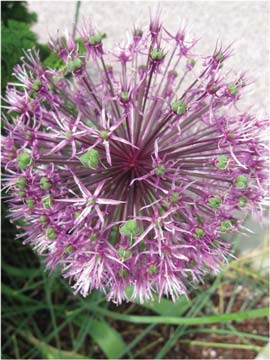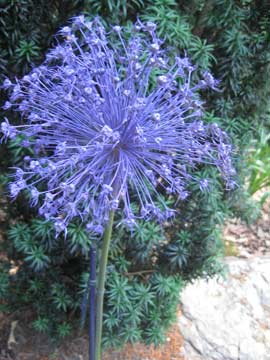Purely ornamental versions of edible plants are all the rage right now. In your local garden center, you’ll find fancy versions of Kale, Cabbages, and Hot Peppers. Ornamental versions of onions (Allium sp.) are also joining the club. (Technically, they are still all edible, but are bred to be pretty and not for optimal flavor.)
 Gladiator allium
Gladiator allium
© Kathy Jentz
 Spray painted allium
Spray painted allium
© Kathy Jentz
 Alliums in a garden setting
Alliums in a garden setting
© Kathy Jentz
Allium bulbs are low-maintenance. Plant them in mid- to late-fall and wait for the foliage to emerge next spring. Most of them will bloom in summer, though a few varieties are earlier and later in the season. Pick a sunny, well-draining spot to plant them. They will multiply for you when given excellent drainage. If they spend their winter with wet roots, they will rot and not return reliably. Fertilize with a general garden fertilizer when you fertilize your other perennials in spring and summer.
Allium selections are expanding in bulb catalogs and in stores. Commonly available ones include 'Purple Sensation,' 'Lucy Ball', and 'Gladiator'. Look out for the nodding onions too. A. cernuum is an American native that can handle part-shade and will naturalize. Seek out the show-stopping ‘Hair’ Allium (A. vineale) and A. schubertii.
If you want drama in your garden, Alliums can definitely provide that. The more unusual varieties are often compared to Dr. Seuss illustrations, while others are referred to as garden "fireworks" or "meteor showers". You can even make the show last long past peak-bloom by cutting and drying the flower stems for indoor arrangements. If you like the way they look in the garden, a can of floral spray paint comes in handy. The drying blooms can be zapped with a bit of their natural color to freshen them up or given a metallic makeover with a shot of silver, bronze, or gold paint.
Good companion plants for Alliums include Hardy Geraniums, Ornamental Grasses, and shorter cultivars of the native American prairie plants like Echinacea and Rudbeckia. Alliums look best when surrounded by shorter groundcover. They also make a statement in small groupings of odd numbers. Groups of three and five per planting hole are nicer, than onesy-twosey or soldiers-all-in-a-row plantings.
If your garden is troubled by deer and rodents, Alliums are a great addition. Not only are they critter-proof, but they also discourage grazing of adjacent plants. Placing allium bulbs among your tulip beds is an easy way to protect the more vulnerable bulbs from becoming deer fodder.
Finally, while meant as ornamentals, the flower heads can lend a bit of spice and color to salads and other dishes as a garnish – just remember that a little bit goes a long way when using these ornamental varieties.
By Kathy Jentz